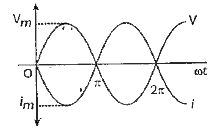For ohmic conductor current voltage graph is a_________
The correct Answer is:straight line
Similar Questions
State the relation correlating the electric current flowing in a conductor and the voltage applied across it. Also draw a graph to show this relationship.
View SolutionWhat is an ohmic resistor ? Give one example of an ohmic resistor. Draw a graph to show its currentvoltage relationship. How is the resistance of the resistor determined from this graph ?
View Solution
Knowledge Check
Assertion: For good conductors, the I-V graph is a perfect straight line inclined to current axis.
Reason: By Ohm's law, voltage across the ends of a conductor is directly proportional to the resistance of the conductor.AIf both assertion and reason are true and reason is the correct explantion of assertion.BIf both assertion and reason are true and reason is not the correct explantion of assertion.CIf assertion is false but reason is true.DIf assertion is true but reason is false.Assertion: For good conductors, the I-V graph is a perfect straight line inclined to current axis.
Reason: By Ohm's law, voltage across the ends of a conductor is directly proportional to the resistance of the conductor.AIf both assertion and reason are true and reason is the correct explantion of assertion.BIf both assertion and reason are true and reason is not the correct explantion of assertion.CIf assertion is false but reason is true.DIf assertion is true but reason is false.Pure resistor, current and voltage are in same phase in which graph?
A B
B C
C D
D
The graph shown in the figure represents a plot of current versus voltage for a given semi-conductor. Identify the region, if any, over which the semicondutor has a negative resistance.

View SolutionIs the graph showing variation of current versus voltage for a diode linear or non-linear?
View SolutionPlot a graph showing variation of current versus voltage for the material GaAs
View SolutionPlot a graph showing variation of current versus voltage for the material Ga.
View SolutionPlot a graph showing variation of current versus voltage for the material Ga.
View Solution
